Features
RIDDHI-MA:
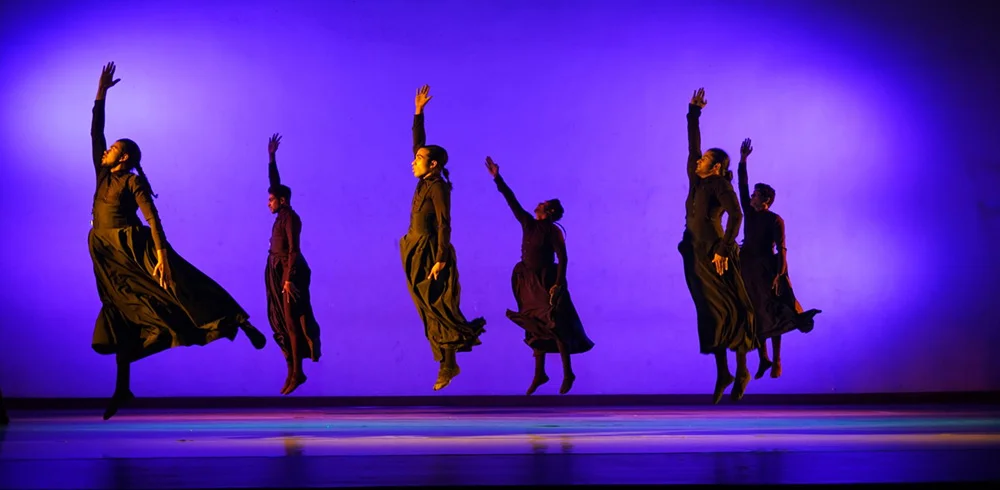
A new Era of Dance in Sri Lanka
Kapila Palihawadana, an internationally renowned dancer and choreographer staged his new dance production, Riddhi-Ma, on 28 March 2025 at the Elphinstone theatre, which was filled with Sri Lankan theatregoers, foreign diplomats and students of dance. Kapila appeared on stage with his charismatic persona signifying the performance to be unravelled on stage. I was anxiously waiting to see nATANDA dancers. He briefly introduced the narrative and the thematic background to the production to be witnessed. According to him, Kapila has been inspired by the Sri Lankan southern traditional dance (Low Country) and the mythologies related to Riddhi Yâgaya (Riddi Ritual) and the black magic to produce a ‘contemporary ballet’.
Riddhi Yâgaya also known as Rata Yakuma is one of the elaborative exorcism rituals performed in the southern dance tradition in Sri Lanka. It is particularly performed in Matara and Bentara areas where this ritual is performed in order to curb the barrenness and the expectation of fertility for young women (Fargnoli & Seneviratne 2021). Kapila’s contemporary ballet production had intermingled both character, Riddi Bisaw (Princes Riddhi) and the story of Kalu Kumaraya (Black Prince), who possesses young women and caught in the evil gaze (yaksa disti) while cursing upon them to be ill (De Munck, 1990).
Kapila weaves a tapestry of ritual dance elements with the ballet movements to create visually stunning images on stage. Over one and a half hours of duration, Kapila’s dancers mesmerized the audience through their virtuosic bodily competencies in Western ballet, Sri Lankan dance, especially the symbolic elements of low country dance and the spontaneity of movements. It is human bodily virtuosity and the rhythmic structures, which galvanised our senses throughout the performance. From very low phases of bodily movements to high speed acceleration, Kapila managed to visualise the human body as an elevated sublimity.
Contemporary Ballet
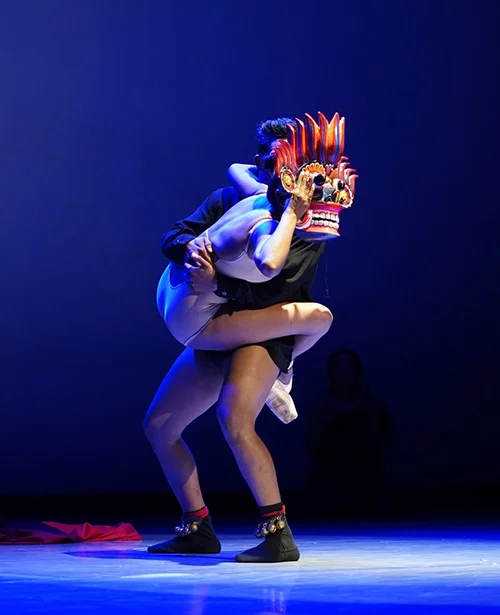
Figure 2 – (L) Umesha Kapilarathna performs en pointe, and (R) Narmada Nekethani performs with Jeewaka Randeepa, Riddhi-Ma, at Elphinstone Theatre, Maradana, 28th March 2025. Source:
Malshan Witharana
The dance production Riddhi-Ma was choreographed in several segments accompanied by a flow of various music arrangements and sound elements within which the dance narrative was laid through. In other words, Kapila as a choreographer, overcomes the modernist deadlock in his contemporary dance work that the majority of Sri Lankan dance choreographers have very often succumbed to. These images of bodies of female dancers commensurate the narrative of women’s fate and her vulnerability in being possessed by the Black Demon and how she overcomes and emancipates from the oppression. In this sense, Kapila’s dancers have showcased their ability to use the bodies not much as an object which is trained to perform a particular tradition but to present bodily fluidity which can be transformed into any form. Kapila’s performers possess formlessness, fluid fragility through which they break and overcome their bodily regimentations.
It was such a highly sophisticated ‘contemporary ballet’ performed at a Sri Lankan theatre with utmost rigour and precision. Bodies of all male and female dancers were highly trained and refined through classical ballet and contemporary dance. In addition, they demonstrated their abilities in performing other forms of dance. Their bodies were trained to achieve skilful execution of complex ballet movements, especially key elements of traditional ballet namely, improvisation, partnering, interpretation and off-balance and the local dance repertoires. Yet, these key ballet elements are not necessarily a part of contemporary ballet training (Marttinen, 2016). However, it is important for the dance students to learn these key elements of traditional ballet and use them in the contemporary dance settings. In this sense, Kapila’s dancers have achieved such vigour and somatic precision through assiduous practice of the body to create the magic on stage.
Pas de deux
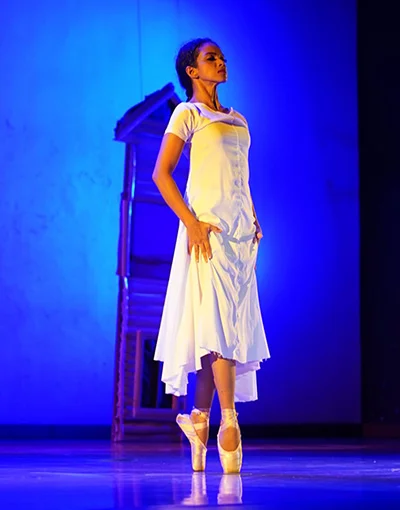
Among others, a particular dance sequence attracted my attention the most. In the traditional ballet lexicon, it is a ‘pas de deux’ which is performed by the ‘same race male and female dancers,’ which can be called ‘a duet’. As Lutts argues, ‘Many contemporary choreographers are challenging social structures and norms within ballet by messing with the structure of the pas de deux (Lutts, 2019). Pas de Deux is a dance typically done by male and female dancers. In this case, Kapila has selected a male and a female dancer whose gender hierarchies appeared to be diminished through the choreographic work. In the traditional pas de deux, the male appears as the backdrop of the female dancer or the main anchorage of the female body, where the female body is presented with the support of the male body. Kapila has consciously been able to change this hierarchical division between the traditional ballet and the contemporary dance by presenting the female dominance in the act of dance.
The sequence was choreographed around a powerful depiction of the possession of the Gara Yakâ over a young woman, whose vulnerability and the powerful resurrection from the possession was performed by two young dancers. The female dancer, a ballerina, was in a leotard and a tight while wearing a pair of pointe shoes (toe shoes). Pointe shoes help the dancers to swirl on one spot (fouettés), on the pointed toes of one leg, which is the indication of the ballet dancer’s ability to perform en pointe (The Kennedy Centre 2020).
The stunning imagery was created throughout this sequence by the female and the male dancers intertwining their flexible bodies upon each other, throwing their bodies vertically and horizontally while maintaining balance and imbalance together. The ballerina’s right leg is bent and her toes are directed towards the floor while performing the en pointe with her ankle. Throughout the sequence she holds the Gara Yakâ mask while performing with the partner.
The male dancer behind the ballerina maintains a posture while depicting low country hand gestures combining and blurring the boundaries between Sri Lankan dance and the Western ballet (see figure 3). In this sequence, the male dancer maintains the balance of the body while lifting the female dancer’s body in the air signifying some classical elements of ballet.
Haptic sense

Figure 3: Narmada Nekathani performs with the Gara Yaka mask while indicating her right leg as en pointe. Male dancer, Jeewaka Randeepa’s hand gestures signify the low country pose. Riddhi-Ma, Dance Theatre at Elphinstone Theatre, 28th March 2025. Source: Malshan Witharana.
One significant element of this contemporary ballet production is the costume design. The selection of colour palette, containing black, red and while combining with other corresponding colours and also the costumes which break the traditional rules and norms are compelling. I have discussed in a recent publication how clothes connect with the performer’s body and operate as an embodied haptic perception to connect with the spectators (Liyanage, 2025). In this production, the costumes operate in two different ways: First it signifies sculpted bodies creating an embodied, empathic experience.
Secondly, designs of costumes work as a mode of three dimensional haptic sense. Kapila gives his dancers fully covered clothing, while they generate classical ballet and Sinhalese ritual dance movements. The covered bodies create another dimension to clothing over bodies. In doing so, Kapila attempts to create sculpted bodies on stage by blurring the boundaries of gender oriented clothing and its usage in Sri Lankan dance.
Sri Lankan female body on stage, particularly in dance has been presented as an object of male desire. I have elsewhere cited that the lâsya or the feminine gestures of the dance repertoire has been the marker of the quality of dance against the tândava tradition (Liyanage, 2025). The theatregoers visit the theatre to appreciate the lâsya bodies of female dancers and if the dancer meets this threshold, then she becomes the versatile dancer. Kandyan dancers such as Vajira and Chithrasena’s dance works are explored and analysed with this lâsya and tândava criteria. Vajira for instance becomes the icon of the lâsya in the Kandyan tradition. It is not my intention here to further discuss the discourse of lâsya and tândava here.
But Kapila’s contemporary ballet overcomes this duality of male-female aesthetic categorization of lâsya and tândava which has been a historical categorization of dance bodies in Sri Lanka (Sanjeewa 2021).
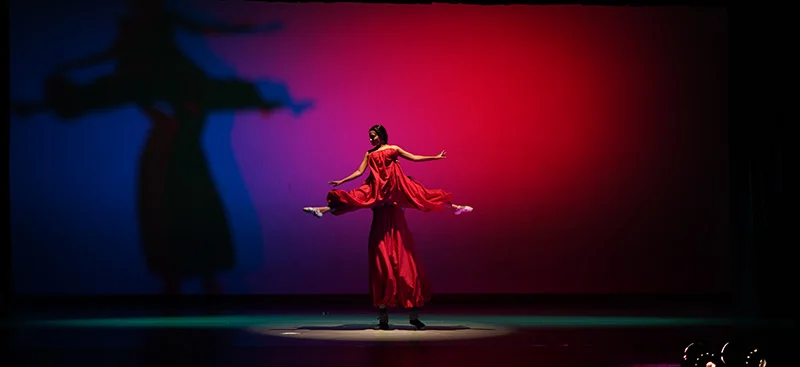
Figure 4: Riddhi-Ma’s costumes creates sculpted bodies combining the performer and the audience through empathic projection. Dancers, Sithija Sithimina and Senuri Nimsara appear in Riddhi-Ma, at Elphinstone Theatre, 28th March 2025, Source, Malshan Witharana.
Conclusion
Dance imagination in the Sri Lankan creative industry exploits the female body as an object. The colonial mind set of the dance body as a histrionic, gendered, exotic and aesthetic object is still embedded in the majority of dance productions produced in the current cultural industry. Moreover, dance is still understood as a ‘language’ similar to music where the narratives are shared in symbolic movements. Yet, Kapila has shown us that dance exists beyond language or lingual structures where it creates humans to experience alternative existence and expression. In this sense, dance is intrinsically a mode of ‘being’, a kinaesthetic connection where its phenomenality operates beyond the rationality of our daily life.
At this juncture, Kapila and his dance ensemble have marked a significant milestone by eradicating the archetypical and stereotypes in Sri Lankan dance. Kapila’s intervention with Riddi Ma is way ahead of our contemporary reality of Sri Lankan dance which will undoubtedly lead to a new era of dance theatre in Sri Lanka.
References
De Munck, V. C. (1990). Choosing metaphor. A case study of Sri Lankan exorcism. Anthropos, 317-328. Fargnoli, A., & Seneviratne, D. (2021). Exploring Rata Yakuma: Weaving dance/movement therapy and a
Sri Lankan healing ritual. Creative Arts in Education and Therapy (CAET), 230-244.
Liyanage, S. 2025. “Arts and Culture in the Post-War Sri Lanka: Body as Protest in Post-Political Aragalaya (Porattam).” In Reflections on the Continuing Crises of Post-War Sri Lanka, edited by Gamini Keerawella and Amal Jayawardane, 245–78. Colombo: Institute for International Studies (IIS) Sri Lanka.
Lutts, A. (2019). Storytelling in Contemporary Ballet.
Samarasinghe, S. G. (1977). A Methodology for the Collection of the Sinhala Ritual. Asian Folklore Studies, 105-130.
Sanjeewa, W. (2021). Historical Perspective of Gender Typed Participation in the Performing Arts in Sri Lanka During the Pre-Colonial, The Colonial Era, and the Post-Colonial Eras. International Journal of Social Science And Human Research, 4(5), 989-997.
The Kennedy Centre. 2020. “Pointe Shoes Dancing on the Tips of the Toes.” Kennedy-Center.org. 2020 https://www.kennedy-center.org/education/resources-for-educators/classroom-resources/media- and-interactives/media/dance/pointe-shoes/..
Acknowledgements
The author wishes to thank Himansi Dehigama for proofreading this article.
About the author:
Saumya Liyanage (PhD) is a film and theatre actor and professor in drama and theatre, currently working at the Department of Theatre Ballet and Modern Dance, Faculty of Dance and Drama, University of the Visual and Performing Arts (UVPA), Colombo. He is the former Dean of the Faculty of Graduate Studies and is currently holding the director position of the Social Reconciliation Centre, UVPA Colombo.
Features
Transforming Sri Lanka: Catalyst role of education in a holistic growth

Formal education is considered a structured process that helps individuals acquire knowledge, develop skills, and shape attitudes through instruction, training, research, and experiment. It fosters critical thinking, analytical skills, creative imagination, intellectual maturity, practical competencies, social awareness, and emotional equilibrium. In that sense, education is vital for the development of the economy, society, and governance. Therefore, a country’s education is one of the fundamental factors that influences its future portrayal. In a universal sense, education can somewhat trigger the desired transformation of Sri Lanka, along with her sustainable, inclusive, and holistic development.
A well-streamlined educational system can help shape future leaders by developing their critical thinking, creative imagination, harmonious collaboration, precise communication, and efficient decision-making skills. That is how the products of education can be expected to promote innovation, teamwork, and self-worth while mentoring others to trust in the devolution of power, drive national development, and transform communities. But the education system in Sri Lanka still seems guided largely by rote learning instead of creative and analytic thinking. Education should nurture a leader by building skills critical for their future success in terms of problem-solving, collaboration, communication, and decision-making-and not merely memorization.
The blend of education with upward leadership components is thus important in raising the development of this nation. In furtherance of leadership into the education system, Sri Lanka can create human resources, interested in changing partners through a spirit of innovation, curiosity, and collectivity. While service-based initiatives, mentoring, sports, art, and social-exchange programs enhance self-confidence, accountability, and leadership skills in students for acknowledgment of various opportunities, progressive education, in turn, will prepare graduate students that are responsible look-forward leaders fully aware of their social responsibilities to national development.
The economy of a country is very much dependent on the people competency, which innovation and willing support development of a qualified and cultured workforce. These, consequently, support industrial development, sustainability, productivity, and competitiveness in the global market. Adequate manpower is basic in industries as it generates expertise and leadership, thus enabling effective contribution to economic growth and improvement of status. Education lays the foundation for training future leaders with technical and social skills to face professional challenges with utmost confidence and efficacy.
Sri Lanka could adapt successful educational policies toward the realisation of vocational aspirations that reaffirm the central role of research, entrepreneurship, and the alignment of education with market demand, much like Finland, Singapore, and Germany. With educational systems aligned with global standards, multinational companies, actively seeking highly qualified employees, may closely align their agendas with Sri Lanka’s future prospects. This may encourage a step toward bringing forth such initiatives and nurturing future entrepreneurs who may be less inclined to full-time employment but are focused on diversifying the economic base. Many countries such as Finland have successfully adopted such models, and Sri Lanka can use them in forming a globally competitive workforce. Furthermore, a better-educated workforce attracts foreign investment as multinational corporations seek trained manpower from various sectors: IT, engineering, healthcare, finance, etc. In addition to that, competent educational institutions, being the center of research and development (R&D) work, remain desirable to companies in the sedate sectors of the industry. Singapore is an example: here, innovation, entrepreneurship, and R&D thrive, further indeed creating an investment-friendly environment that serves as a true engine behind economic transformation-Sri Lanka should therefore take a cue from this.
A well-functioning education system nurtures creativity and innovation, the backbone of an economic breakthrough. If universities in Sri Lanka begin to train in entrepreneurship and extend opportunities for research, this country can enable innovation to flourish. The establishment of startup ecosystems in developed countries has added value by providing students access to the resources and support to develop and commercialize their ideas. Such an approach in Sri Lanka helps contribute to a new generation of entrepreneurs who will be less dependent on conventional employment steering the country toward diversification in its economy. Education is crucial for national development, fostering skilled professionals, responsible citizens, and visionary leaders. A sound education system can drive economic growth, social progress, and governance improvement. Whereas Sri Lanka needs to evolve from rote memorization to a modern critical thinking, problem-solving, and innovative system, the more aligned its education is with global standards, the better will Sri Lankan youth be able to compete globally, thus boosting the knowledge economy.
Investment in education is essential for economic growth and social equality. The educated and skilled labor force earns high incomes, creates expanded markets for consumers, and activates other industries, enhancing sustainable development. Education does eradicate poverty through enabling individuals to obtain a livelihood with sufficient income for improved living standards and financial security. It creates a balance between work and life along with mental health well-being, leading to job satisfaction and an overall sense of well-being. It provides the competitive workforce that enhances the competitiveness of industries in the international market. Strategic educational reforms should be undertaken in Sri Lanka in a manner focused on competency-based curricula, teacher training, and STEM education that will enable it to introduce the labor market requirements and long-term economic growth. Developing research and development and collaboration between industry and academia would allow Sri Lanka to become a knowledge-based economy. Education should build the managerial skills that allow people to develop programs in business, finance, and entrepreneurship. Modern teacher training and individualized student preparation for entrepreneurship outside the classroom are investments that can raise quality and generate productive education.
cation is a vast area, equally important in providing values, fostering social cohesion, and ensuring social inclusion for the development of society. It invests energy in directing learners toward self-awareness, equipping them with knowledge and skills, contributing to community and societal good endeavors. It is a vital pathway to achieve social equity and inclusion, alleviating the disparities in society through uplifting poorer communities. It is conducive to social mobility and disengaging society from suffering. Exposure to different viewpoints allows learners to better understand appreciation of different cultures, backgrounds, and options, which consequently enhances personal social capital and trust. Through education one inculcates democracy- meaning that he or she participates in governmental processes and movements for social justice. It makes one acquainted with his or her rights and duties, and political and economic structure of the state–thus he or she aids in the up-gradation of society. Education develops characters; it also develops qualities such as perseverance, versatility, helps curb down stress. Well-being becomes an important part of the amiable and active personality of a student leading to their graduation. Education is therefore supposed to be intertwined with social development; social inclusion, civic involvement, and mental well-being are a case in point through empowerment of societies initiated towards inclusion, cohesion, and resilience. Education infused with creativity and motivation will enable development of knowledge, skills, competencies of individuals as his or her contribution towards social well-being.
Sri Lankan education system now needs to give priority to STEM education, entrepreneurship, and digital literacy to provide its students with the tools that can cater to the needs of industries such as ICT, healthcare, agriculture, engineering, and finance. Engagement with the private sector will greatly enhance education and employment, thus fostering innovation and technology through student internships, mentorships, and scholarships. Universities must also invest in R&D, as can be seen in countries such as Finland, Singapore, and Germany. The importance of an education-led economy has been demonstrated by the examples of such countries in terms of attracting multinationals and offering high-quality job opportunities. On the other hand, building the educational system in Sri Lanka according to market needs in engineering, agriculture, technology, entrepreneurship, and digital literacy will create a bridge into the industry. Strong vocational training and modernized technical education will arm the Sri Lankan child with skills that can serve several industries.
Education should not merely enlighten the mind but rather cultivate an entrepreneurial mindset, with curricula incorporating financial literacy, business management, and entrepreneurship incubation to empower students to open their own businesses rather than relying on traditional wage employment. Universities should build business innovation hubs and startup incubators where students can have access to funding, mentoring, and technological resources while developing their problem-solving capacity through project-based learning and application in real-time.
Sri Lanka grudgingly creates room for a more competency-based education to foster creativity and analytical thinking through a bunch of class-based examination-driven assessments in place. Continuous assessment through project-based evaluation, public presentations, and problem-solving tasks empowers learners to apply their knowledge instead of rote learning. Interdisciplinary learning and experiential education should be encouraged to present learners with lived experience challenges. Education is a lifelong process that extends well beyond the confines of knowledge acquisition. Moreover, education brings about qualities of love, empathy, and leadership, which are very essential for one to develop personally and for the growth of society. This inspired Sri Lanka to develop a reform that not only enhances academic success but also instills such skills. Sri Lanka can on this broad, inclusive vision of education so that its future generations will be provided with the skills and competencies to sustain their place in society in a fast-changing world, both in terms of professional and personal choices. This will serve to build a more innovative, compassionate, and competent society.
Moving away from information-based to a competency-based system represents a paradigm shift in the promotion of creativity and analytical thinking. Through continuous and ongoing assessments-across project work, public presentations, and problem-solving students will then be able to apply their knowledge in real-life contexts, further training their minds for independent and innovative thought. Beyond this, interdisciplinary learning and experiential education would allow students to attach concepts across subjects, fostering their ability to apply learning to concrete situations and therefore prepare them to face real-life challenges with confidence. This shift will foster in them a generation of learners, which will grow up wise, adaptable, resourceful, and ready to make meaningful contributions to society.
Sri Lanka is at a pivotal point where its education system needs to be transformed completely to meet the demands of the 21st century. The paradigm shift must not only be aimed at modernizing schooling practices but also on promoting leadership, economic relevance, entrepreneurship, and social equity to produce a skilled workforce capable of powering on sustainable growth. A skill-based education system on a progressive curriculum, fueled by teacher training and R&D, would prepare students for the practicalities of tomorrow. In doing so, Sri Lankans can emerge as mentors in innovation, entrepreneurship, and holistic national development. The highly skilled and adaptable labor force trained in what would become the crucial education sector could later help develop sustainable growth for the nation that continues to do well in an increasingly complicated world environment. This will empower education to develop as a locomotive to bring Sri Lanka along the road to leadership in innovation, entrepreneurship, and all-round development. An investment like this will assure future generations of an entity with resilience and prosperity. (Views expressed in this article are personal.)
by Dr. S.G.S. Samaraweera
University of Ruhuna
sanjaya@eltu.ruh.ac.lk
Features
How grateful are we as a nation?
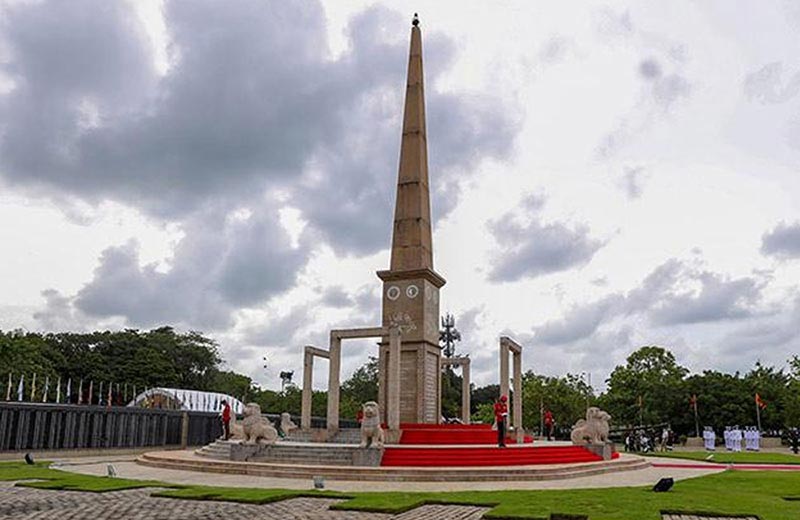
I recently visited the National War Memorial at Battaramulla. I do so every year to pay my respects to our war heroes, especially two of my close friends, one from the Army and other from the Navy––Colonel Fazly Laphir, PWV, RWP, RSP and Commander Parakrama Samaraweera, WWV, RSP.
Those two brave officers paid the supreme sacrifice for the sake of the country during an operation to rush reinforcements to the besieged Mullaitivu Army Complex in July 1996.
One Sri Lanka Light Infantry Corporal, who joined the Army in 2010, opened the gate for me at the memorial and saluted. He recognised me! Two Army civilian workers were mowing the turf. I was really impressed!
The Army is properly maintaining the National War Memorial. Bravo Zulu to our Army !
The Corporal at the gate said that I was the third person to visit the Memorial during the weekend, other than two families of the Army personnel who were considered Missing In Action (MIA) during the Mullaitivu debacle 29 years ago.
I had ample time. After locating the two names of my buddies; Fazly and Nalaka (Parakrama’s pet name was Nalaka), I decided to count the names of those who had died on 18 July 1996 in Mullaitivu. I was helped by my escort, Chief Petty Officer (SBS) Kumara. We together counted 1.160 NAMES OF ARMY PERSONNEL and 34 NAVY PERSONNEL!
Can we forget these brave men who laid down their lives for their motherland?
Please Google Colonel Fazly Laphir and Commander Parakrama Samaraweera to read about their heroic acts in the Mullaitivu battle. Fazly was awarded Parama Wira Vibushanaya ( PWV), the highest Gallantry Medal in Sri Lanka and Commander Parakrama Samaraweera Weera Wickrama Vibushanaya ( WWV), the second highest Gallantry Medal of Sri Lanka for their efforts to save 1,700 troops trapped in the Mullaitivu camp during an LTTE attack.
By Admiral Ravindra C Wijegunaratne
WV, RWP and Bar, RSP, VSV, USP, NI (M) (Pakistan), ndc, psn, Bsc
(Hons) (War Studies) (Karachi) MPhil (Madras)
Former Navy Commander and Former Chief of Defense Staff
Former Chairman, Trincomalee Petroleum Terminals Ltd
Former Managing Director Ceylon Petroleum Corporation
Former High Commissioner to Pakistan
Features
TWO AGELESS AND SPIRITUAL TREES IN THE VILLAGE TANK

Agbo the Tusker, named after nine kings with the same name and presently celebrated as royalty among wild elephants in Sri Lanka, limps as he inches towards the rank grove of Nabada (Vitex leucoxylon) and Kumbuk (Terminalia arjuna) trees seeking shade at the upper section of the Ulagalla tank near Tirappane, in the North Central Province. The much adored and, sadly, injured elephant has chosen this tank and the surrounding area to live alone to escape pestering from macho elephants who stray out from Kalaweva and Mahakanadarawa Forest Reserves.
Hoping to rest, he stops under a large and ailing Nabada tree. Shapeless openings in its midsection show it is hollow. As I shall recount later, according to Sri Lankan history books, a similar tree growing in water at the Doramadalawa tank (Dwaramandalaka in Mahawansa), approximately 20 kilometers north of here, once had royal contact, literally, saving future King Pandukabhaya from certain death when he was still a boyish prince.
I suggest this tree is the Nabada, for no other tree with holes and a tunneled trunk big enough for a boy to hide grows in water in a dry zone tank. The other tree in the grove, the Kumbuk, carries the credentials of being a spiritual tree, as depicted in Buddhist literature.
Unlike the mother of all Sri Lankan trees – the Sri Maha Bodhi Tree (Ficus religiosa) about which written volumes, nothing significant has been recorded about the Nabada and its companion Kumbuk, two large and unassuming trees standing at odd intervals like deformed Doric columns in and around the village tanks, temples of prosperity in the Dry Zone. They also do not possess the pedigree and vanity of showier trees, such as ebony and mahogany in Sri Lanka, or the stately 4,856-year-old Bristlecone pine tree named Methuselah, still surviving in the Eastern California desert. But Nabada and Kumbuk trees are the inseparable violin and the viola in the symphony which I call the part and parcel of the village tank.
The Village Tank is a book of poetry that nurtures fascination and imagination. The two trees in this narrative double this magic by refreshing the equity and appeal surrounding this core asset of the village. As much as it is a repository for lifesaving water for the villagers, the tank hosts an ambiance of beauty rarely surpassed by any other aspect of the village. A part of this setting is the vegetation that abounds in it, both in dry and wet seasons. Nabada and Kumbuk trees lead this parade.
Blood relatives of Nabada and Kumbuk trees grew on the ephemeral stream long before villagers dammed it up, some probably centuries ago, in a process called gambendeema. When the dammed area was inundated, most trees and shrubs trapped in the deluge drowned, leaving their dead branches like skeletons of dinosaurs sticking out in a pond. Nabada and Kumbuk trees, loaded with DNA ready for amphibious life, refused to die and continued to thrive in this new setting.
A Nabada tree will live for hundreds of years. As it grows old, its pith dissolves away, but it still retains enough muscle to hold it standing. A grove of such old and faded trees may give the tank a primitive expression. Some trees refused to move to the water’s edge and remained in the middle like the one Pandukabhaya dived to hide.
They nevertheless hold the Primus position growing on the bund and the tank’s upper reach, called gasgommana or wev-thavulla which are essential ecotones in the larger tank environment. They also grow in the marshy area called kattakaduwa, between paddy fields and homesites called gammedda, and in elangawa, a free-standing forest between two tanks in a cascade of tanks.
Nabada Tree in History
Nabada tree is the ‘elephant in the tank.’ No one notices it out there, right in the open. These trees stand like illustrations of unknown monster animals drawn in ancient maps by medieval cartographers to fill uncharted regions in world. Monsters or not, a verdant mass of green, this tree is there, providing breeding grounds for fish when the tank is full to the brim, and a shady haven for cattle to rest when metallic heat of the unforgiving sun punishes the dusty tank bed during hot months.
The Nabada tree grows in the village tank like an outcast. In a way, it is a good thing. Unlike the Kumbuk tree, which has become a victim of homebuilders who dismantle it to build flavoured steps to reach upstairs rooms, the Nabada tree has never found favor in this convenient therapy in homes or horticulture business in modern times along the borders of expressways.
Genealogic itinerary of these two trees run back in history. Thus, the influence and association of them on villagers’ lives are more pronounced than one thinks. For example, these trees became part of the village nomenclature, showing an instance of interesting footnote in our colonial history.
Until the 19th century, many present-day village tanks had been abandoned, nameless, or derelict. Then, a group of pioneer families looking for a new settlement would descend to such a place and restore the ruined dam through a communal custom called gambendeema.
At the time of entering the details of this project into government records in the early colonial irrigation department, clerks or technical officers, who were mainly Tamils and well-versed in English but less proficient in Sinhala, assigned names to identify these settlements using Tamil words for convenience. These words represented the physical or forestry features found in and around the immediate surroundings of the village. Thus, Nochchikulama, just a kilometer from my village, or Nabadawewa, is an eponym of the Nabada tree. In Tamil, Nochi is Nabada, and Kulam is wewa. Unsurprisingly, even today, Nochchikulama has over a dozen Nabada trees in its tank.
As a side note, as early as 1816, on the Jaffna Peninsula, there were over 600 students enrolled in Wesleyan missionary schools, learning English. Understandably, they got jobs to advance emerging irrigation projects of colonial administration in the Northern Province, which included all the NCP until 1873.
The Sri Lankan chronicle Mahawansa records that Prince Pandukabhaya, who later became the king and ruled Sri Lanka from 307 to 377 BC, was seven years old and in exile in the village of Doramadalawa (Dwaramandalaka in Mahawansa) near Mihintale for fear of being killed by his uncles, who were eyeing the throne in nearby Anuradhapura. One day, while swimming with friends in the village tank, he saw a band of assassins approaching them with swords drawn.
He grabbed his clothes, dived underwater, and headed straight to the hollow section in a tree growing in the water not far from the mankada. He hid there for a while and came out only after the killers had left, thinking that all the boys, including the prince, had been killed, because there were no additional sets of clothes found on the tank bund.
Kumbuk Tree
This tree is a giant, growing over 50 meters tall, supported by a whitish trunk, some of which are about five metres in circumference at their base. A man can easily take cover between its root buttresses.
Around the latter half of the 20th century, when restrictions on harvesting timber in the country began to take effect, carpenters sought alternative sources to supplement their trade. They caught the scent of the Kumbuk tree, and soon the bells of doom for it began to toll, as the phenomenon of timber products harvested from it has become the darlings of carpenters and home builders. The timber of this tree is popular for use in floorboards and treadboards on stairs in multi-story homes. Before the advent of sawmill noise, villagers allowed these trees to mind their own business in the neighborhoods but guarded them with love. Now, they protect them with vigour.
Meanwhile, this tree is a valuable resource for villagers, but not for its timber. They believe the roots of the tree have water-purifying qualities. Before the village had running water, residents did their bathing chores at the naana mankada (bathing ford), where the Kumbuk tree usually provided shade. Women collected drinking water under this tree, which also grew near diya mankada (drinking water ford), located away from the bathing ford. During the dry season, as the water turned to a mustard color, they brought home this water in an earthen pot, rubbed the seeds of the Ingini tree (Strychnos potatorum) on its inner surface, and left it overnight for the muddy residue to settle to the bottom.
The Kumbuk tree is also a popular spot for village children to enjoy fun outings. They climb its lower branches running horizontally over water, and use them as diving platforms. On some days, we sit on a branch of this tree on the edge of the embankment and watch shoals of fish roam around under its shade. A villager hoping to upgrade his dinner menu often comes and sits by this tree, throws a line, and waits for any movement of the floater.
He picked the right place. The tall and partly submerged buttress root system and crevices provide secure nooks for fish to lay eggs and raise their young. Fishermen know that this lure attracts predator fish to hang around under this tree.
The Kumbuk tree invites tranquility and character to the tank and gammedda below the bund. Thus, this tree too became an eponym for some villagers, e.g., Kumbukwewa or Kumbukgate. It also found a niche in Sri Lankan folklore. Henry Parker, an early 20th-century colonial historian and irrigation engineer, heard from villagers the folktale “The Jackal’s Judgment.” A crocodile grabs a man at the foot of the village tank bund. The man then pleads for help from a nearby Kumbuk tree. Without hesitation, the tree tells the crocodile, “Eat him. He cuts the Kumbuk tree branches and takes them home.” The stairs builder, Mr. Carpenter, must read this folktale. If he gets caught in a crocodile’s jaws, the tree might throw out the preamble and say: “Take him home, buddy. It’s your dinner!”
The substantial presence of Nabada and Kumbuk trees on the bund proves that these trees are an integral part of the tank and the village, and are connected to tradition. Contrary to the vile treatment of the Kumbuk tree, it is considered holy in Buddhist culture.
Literature records that two Atawisi Buddhas (28 former Buddhas), Anomadassi and Piyadassi, received enlightenment under a Kumbuk tree. This belief spared it from the axe and adze of man for ages, just like hunters spared the peacock from slaughter because it is venerated as the vehicle of Kataragama Deyyo – Skandha, the guardian deity of Sri Lanka. Thus, at home, each time we walk on the impeccable steps to the upstairs made of Kumbuk planks, we must remind ourselves we are trampling on a sacred tree, and making the village poor with one less tree – both sacrilegious deeds.
Worthy Meeting Place
On the other hand, seeing the Kumbuk trees planted along the roadways is an incredible gift for travelers, and a well-thought-out investment, not for their carpentry potential but for the power of their environmental benefits for years to come.
From its sapling days, I watched the growth of one such linear grove of Kumbuk trees by the side of A9 south of Kekirawa bazaar. Street vendors, who have no seat in the town proper, gather in this grove daily to make a living by hosting a roadside marketplace. A few decades after the trees were introduced, they began to provide a calmer alternative to the hustle and bustle of the nearby town.
Moreover, the Nabada and Kumbuk groves in and around the tank serve as a meeting place for hundreds of aquatic and migratory birds, some of which have adopted it as their permanent or wayside home. During the day, it is their panchayat, the village assembly. They sort out their neighborly affairs and territorial conflicts here. Some work on their tan as you see flocks of black Cormorants do with wings outstretched in the sun while perched atop the canopy after a fishing outing. After nightfall, swarms of fireflies lit up the row of these trees, imitating the blinking bulbs screaming on the pandol carnival on the Wesak city streets.
In the evening, when the darkness creeps in, the Indian Flying Fox bats (Pteropus giganteus) leave the trees for night rounds. On the Nabada and Kumbuk groves by the Nuwara Wewa bund in Anuradhapura, one can hear the pandemonium of screaming birds flying in and joining the fight for room reservations for a good night’s sleep. Those of us who take evening fitness and doctor-advised strolls on the bund, or amorous couples spending the evening away on its embankment have seen the hullabaloo I am writing about.
Whether the tank is full or has gone bone dry, a line of these two trees growing alternately on the botanical horizon along the forest line or along the bund spruces up, adding to the silent grace of the village tank, accentuating a string of diamonds in an empress’s necklace.
Often, when the morning breaks open and the wind dies down, waves in the tank take a recess. Water becomes a sky-blue mirror producing the eternalized reflection of the Kumbuk tree on the edge of the nana mankada. Then, these twins stand ready yearning for a prize-winning photo. I caught that brilliant cadenza of the reflective melody one morning at my village tank. The prosody of that moment was crying to be written. Just staring at that diorama took me to a serene and unclouded moment of reverie.
By Lokubanda Tillakaratne
-

 Sports4 days ago
Sports4 days agoTharanga vows overhaul as Sri Lanka seek T-20 revival ahead of World Cup
-

 Opinion4 days ago
Opinion4 days ago‘Muslims in the Dock’:A clarion call against Islamophobia
-

 Features5 days ago
Features5 days agoThe doctor’s dilemma
-

 Features6 days ago
Features6 days agoCeylon’s path to setting up a university : Public Lecture Series 1918-1921
-

 News4 days ago
News4 days agoMan who tried to smuggle in gold worth Rs. 1.1 bn gets bail
-

 Editorial7 days ago
Editorial7 days agoTrump Tariffs: Will moral suasion work?
-

 Editorial5 days ago
Editorial5 days agoSaving tanks: Rhetoric and reality
-

 News5 days ago
News5 days agoEducation Reforms: Govt. forges ahead amidst widespread protests



















